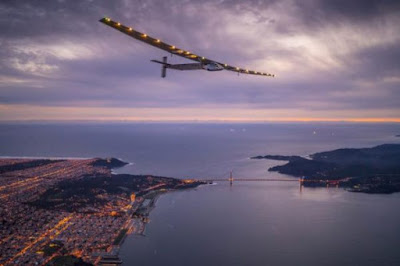A solar-powered airplane midway through a historic bid to circle the globe has on Monday completed the 10th leg of its journey, as it landed in Arizona after a 16-hour flight from California.
The project team said on Tuesday in Arizona that the project was in a campaign to build support for clean energy technologies.
They expressed the hope to eventually complete its circumnavigation in Abu Dhabi, where the journey began in March 2015.
The team said the spindly, single-seat experimental aircraft, dubbed Solar Impulse 2, arrived in Phoenix shortly before 9 PM, following a flight from San Francisco that took it over the Mojave Desert.
They said the flight would have taken a conventional airplane just two hours, but the solar craft’s cruising speed, akin to that of a car, required pilots to take up meditation and hypnosis in training to stay alert for long periods.
Swiss pilot, Andre Borschberg, who is at the helm of the plane that began circumnavigating the earth more than a year ago, described the 16-hour trip “a beautiful flight,” after stepping from the cockpit.
“It is a special flight; not a long flight. The aircraft took off from Mountain View in northern California shortly after 5 AM. It began its globe-circling journey last year, and flew from Hawaii to the Silicon Valley last week,” he said.
Borschberg disclosed that after Phoenix, the plane would make two more stops in the U.S. before crossing the Atlantic Ocean to Europe or northern Africa.
Report said for several minutes after arriving, Borschberg remained aboard as powerful winds buffeted the aircraft, forcing the ground crew to hold down it down with straps.
The pilot noted that sometimes it was more difficult to handle the airplane on the ground than in flight.
Borschberg said the feat, however, dealt a setback to the Solar Impulse, which suffered severe battery damage, requiring repairs and testing that grounded it in Hawaii for nine months.
Fellow Pilot, Bertrand Piccard, said he completed the trans-Pacific crossing last month, reaching San Francisco after a flight of nearly three days, more than three times the 18 hours Amelia Earhart took to fly solo from Hawaii to California in the 1930s.
He said the biggest difference is that the propeller-driven Solar Impulse flies without a drop of fuel, its four engines powered solely by energy collected from more than 17,000 solar cells built into its wings.
“Surplus power is stored in four batteries during the day, to keep the plane aloft on extreme long-distance flights. The carbon-fiber plane, with a wingspan exceeding that of a Boeing 747 and the weight of a family car, is unlikely to set speed or altitude records. It can climb to 28,000 feet (8,500 m), and cruise at 34 to 62 miles per hour (55 to 100 kmh),” he said.
Piccard said the Solar Impulse 2’s wings, which stretch wider than those of a Boeing 747, are equipped with 17,000 solar cells that power propellers and charge batteries.
“The plane runs on stored energy at night. The two legs to cross the Pacific were the riskiest part of the plane’s travels because of the lack of emergency landing sites,” he said.
The project which is estimated to cost more than $100 million began in 2002 to highlight the importance of renewable energy and the spirit of innovation.
By NAN
(adsbygoogle = window.adsbygoogle || []).push({});


